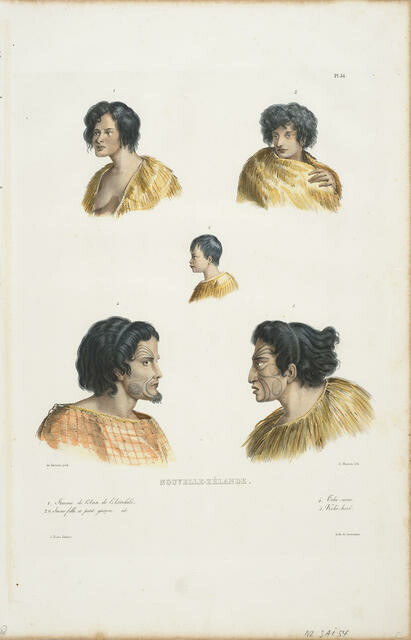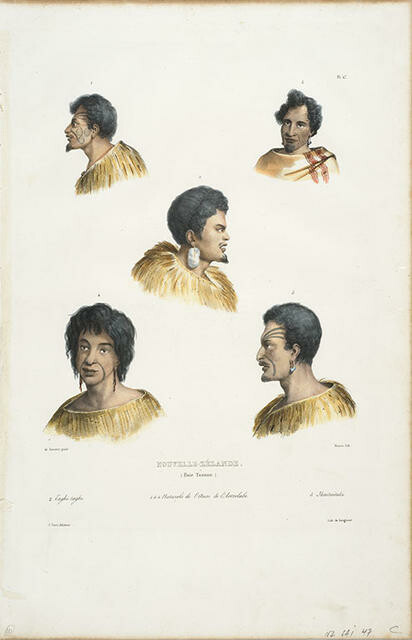Lithographs after Louis de Sainson
Lithographs after Louis de Sainson
Related reading: Ka Honoka
Collection

Louis Auguste de Sainson Coiffures diverses des habitans de Tonga Tabou, lle des Amis
Louis Auguste de Sainson was the official artist aboard Captain Dumont d’Urville’s Astrolabe. He spent three months in New Zealand in 1827 on a maritime mapping survey between Tasman Bay and the Bay of Islands, followed by a month in Tonga. A substantial publication on d’Urville’s 1826–29 voyages through Asia and the Pacific was published in Paris in 1833, profusely illustrated by lithographic prints after de Sainson’s drawings.
D’Urville and his crew had close contact with people they met, including the Totaranui chief Tehinui (or Tehi-Noui) and his travelling companion Kokiore (or Koki-Hore) depicted in print 2, who were sketched by de Sainson after coming aboard at Palliser Bay (near present-day Wellington). Tehinui and Kokiore at first both intended to reach Europe, but instead disembarked at Tolaga Bay, later finding their own way home. In summarising his portrait sketching process, de Sainson later recalled: “What I was doing caused a lot of laughter; every minute they tried to escape me.” (Kā Honoka, 18 December 2015 – 28 August 2016)
Collection

Louis Auguste de Sainson Nouvelle-Zélande
Louis Auguste de Sainson was the official artist aboard Captain Dumont d’Urville’s Astrolabe. He spent three months in New Zealand in 1827 on a maritime mapping survey between Tasman Bay and the Bay of Islands, followed by a month in Tonga. A substantial publication on d’Urville’s 1826–29 voyages through Asia and the Pacific was published in Paris in 1833, profusely illustrated by lithographic prints after de Sainson’s drawings.
D’Urville and his crew had close contact with people they met, including the Totaranui chief Tehinui (or Tehi-Noui) and his travelling companion Kokiore (or Koki-Hore) depicted in print 2, who were sketched by de Sainson after coming aboard at Palliser Bay (near present-day Wellington). Tehinui and Kokiore at first both intended to reach Europe, but instead disembarked at Tolaga Bay, later finding their own way home. In summarising his portrait sketching process, de Sainson later recalled: “What I was doing caused a lot of laughter; every minute they tried to escape me.” (Kā Honoka, 18 December 2015 – 28 August 2016)
Collection

Louis Auguste de Sainson Nouvelle-Zélande
Louis Auguste de Sainson was the official artist aboard Captain Dumont d’Urville’s Astrolabe. He spent three months in New Zealand in 1827 on a maritime mapping survey between Tasman Bay and the Bay of Islands, followed by a month in Tonga. A substantial publication on d’Urville’s 1826–29 voyages through Asia and the Pacific was published in Paris in 1833, profusely illustrated by lithographic prints after de Sainson’s drawings.
D’Urville and his crew had close contact with people they met, including the Totaranui chief Tehinui (or Tehi-Noui) and his travelling companion Kokiore (or Koki-Hore) depicted in print 2, who were sketched by de Sainson after coming aboard at Palliser Bay (near present-day Wellington). Tehinui and Kokiore at first both intended to reach Europe, but instead disembarked at Tolaga Bay, later finding their own way home. In summarising his portrait sketching process, de Sainson later recalled: “What I was doing caused a lot of laughter; every minute they tried to escape me.” (Kā Honoka, 18 December 2015 – 28 August 2016)
Collection
![Nouvelle-Zélande - coffre en bois sculpté [Plate 59]](/media/cache/d2/0d/d20d3e71824f4f302a9ddce9f4f594ca.jpg)
Louis Auguste de Sainson Nouvelle-Zélande - coffre en bois sculpté [Plate 59]
Louis Auguste de Sainson was the official artist aboard Captain Dumont d’Urville’s Astrolabe. He spent three months in New Zealand in 1827 on a maritime mapping survey between Tasman Bay and the Bay of Islands, followed by a month in Tonga. A substantial publication on d’Urville’s 1826–29 voyages through Asia and the Pacific was published in Paris in 1833, profusely illustrated by lithographic prints after de Sainson’s drawings.
D’Urville and his crew had close contact with people they met, including the Totaranui chief Tehinui (or Tehi-Noui) and his travelling companion Kokiore (or Koki-Hore) depicted in print 2, who were sketched by de Sainson after coming aboard at Palliser Bay (near present-day Wellington). Tehinui and Kokiore at first both intended to reach Europe, but instead disembarked at Tolaga Bay, later finding their own way home. In summarising his portrait sketching process, de Sainson later recalled: “What I was doing caused a lot of laughter; every minute they tried to escape me.” (Kā Honoka, 18 December 2015 – 28 August 2016)
Notes

Happy Birthday Akaroa Museum
Big Congratulations to Akaroa Museum on their 50th anniversary which they are celebrating this weekend.
Article

A Tale of Two Chiefs
If you have recently visited He Taonga Rangatira: Noble Treasures at the Gallery you will have been struck by Fiona Pardington's two large photographic portraits of lifelike busts of Ngāi tahu tipuna (ancestors).
Collection

Charles Meryon Nouvelle-Zélande, Presqu’île de Banks. Etat de la petite colonie Française d’Akaroa. Vers 1845 - Voyage du Rhin.
Described as the father of modern etching, French naval officer Charles Meryon was one of the most important artists to work in Waitaha / Canterbury during the colonial era. He served on the Rhin, stationed at Akaroa between 1843 and 1846, to look out for the French settlement there. Meryon made numerous pencil studies at Akaroa which he later used as the basis for this series of etchings completed back in Paris during the 1860s. He planned to publish these and other images of the Pacific in an album, which unfortunately he never completed. The story of the French attempt to settle Te Waipounamu / the South Island is a fascinating chapter in New Zealand’s history. A French whaling captain, Jean Langlois, purchased 30,000 acres from Kāi Tahu on Horomaka / Banks Peninsula in 1838 and returned to France to get government support to establish a French colony at Akaroa. It was from here that he hoped the French would be able to expand throughout the rest of the South Island. A company was formed and sixty- three French and German settlers set sail on the Comte de Paris. They arrived at Akaroa in August 1840 only to find a Union Jack flying at Takapūneke / Green’s Point signalling that British sovereignty had already been claimed. Today, Akaroa continues to retain something of a French flavour.
(Pickaxes and shovels, 17 February – 5 August 2018)
Collection

Charles Meryon Le Ministère de la Marine
Charles Meryon’s fantastical Parisian scene presents the French Admiralty building with a flying horde being delivered from the far ends of the globe. The crowd below is thrown into disarray as Roman charioteers, whales and whaleboats, a waka with sails, an anchor, serpents, cowboys and horses with fishtails prepare for landing.
Meryon’s impaired mental state in this period is the usual explanation given for this extraordinary etching. At the same time, it may be viewed as an image laden with personal symbolism as the confounding facts, fantasies and errors of the past make their perplexing return.
Meryon spent three years in Akaroa from 1843–46 as a young naval cadet, protecting the fledgling French settlement. Although this particular colonising plan did not succeed, the streetlamps of Paris were fed a regular supply of whale oil from Banks Peninsula in this period. For Meryon these were formative years and regularly revisited in his imagination. (Kā Honoka, 18 December 2015 – 28 August 2016)
Collection

John Pule On Another Man’s Land
John Pule examines the complex experience of leaving one’s homeland and arriving in another – a reflection on his own migration from Niue to Aotearoa New Zealand. Using the grid-like composition of hiapo, he has developed a symbolic language of spears, migratory birds, sea creatures and geometric patterning that speaks to personal and shared histories of cross-cultural exchange. Here, he also reproduces an eighteenth-century drawing by Raiatean navigator Tupaia, depicting Captain Cook’s botanist Joseph Banks trading with a rakatira from Uawa. It’s an image that complicates our understanding of the dynamics involved in this encounter, and asks us to consider our own place in Aotearoa.
hiapo ~ barkcloth from Niue
rakatira ~ person of high rank, chief, leader
He Kapuka Oneone – A Handful of Soil (from August 2024)
Collection
Fiona Pardington Portrait of a Life-cast, possibly of ‘Taha-tahala’ [possibly Takatahara], Aotearoa New Zealand
Across her career, Fiona Pardington has a history of working with found objects. This portrait acts to reclaim an image believed to be of her ancestor, Takatahara from Te Pātaka o Rākaihautū / Banks Peninsula. The subject was introduced to the plaster-cast technique of naturalist and phrenologist Pierre Marie Alexandre Dumoutier at Ōtakou during one of his visits to Aotearoa in the early 1800s. Often mistaken for death masks, life-casts were in fact made with the subject’s participation. Takatahara was known as a robust toa (warrior) who fought in, and lived well past, the battle with Te Rauparaha at Ōnawe pā (fortified village).
(Te Wheke, 2020)
Collection

Charles Meryon Nouvelle Zélande, Greniers indigènes et Habitations à Akaroa (Presqu’île de Banks, 1845
Described as the father of modern etching, French naval officer Charles Meryon was one of the most important artists to work in Waitaha / Canterbury during the colonial era. He served on the Rhin, stationed at Akaroa between 1843 and 1846, to look out for the French settlement there. Meryon made numerous pencil studies at Akaroa which he later used as the basis for this series of etchings completed back in Paris during the 1860s. He planned to publish these and other images of the Pacific in an album, which unfortunately he never completed. The story of the French attempt to settle Te Waipounamu / the South Island is a fascinating chapter in New Zealand’s history. A French whaling captain, Jean Langlois, purchased 30,000 acres from Kāi Tahu on Horomaka / Banks Peninsula in 1838 and returned to France to get government support to establish a French colony at Akaroa. It was from here that he hoped the French would be able to expand throughout the rest of the South Island. A company was formed and sixty- three French and German settlers set sail on the Comte de Paris. They arrived at Akaroa in August 1840 only to find a Union Jack flying at Takapūneke / Green’s Point signalling that British sovereignty had already been claimed. Today, Akaroa continues to retain something of a French flavour.
(Pickaxes and shovels, 17 February – 5 August 2018)
